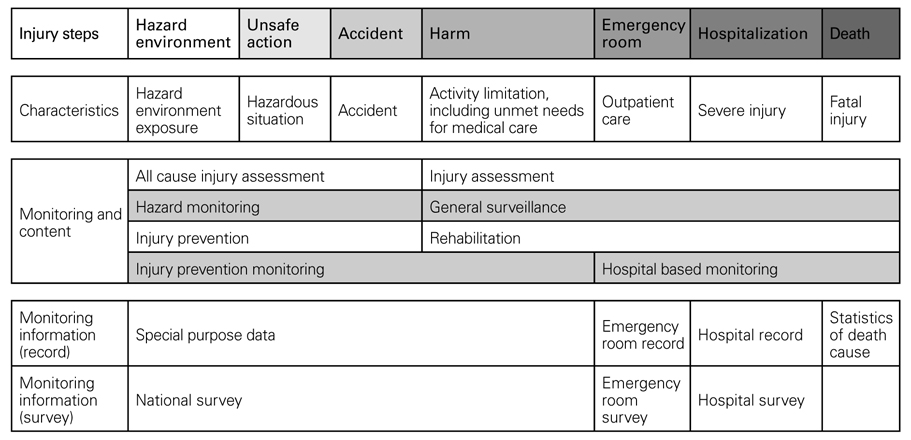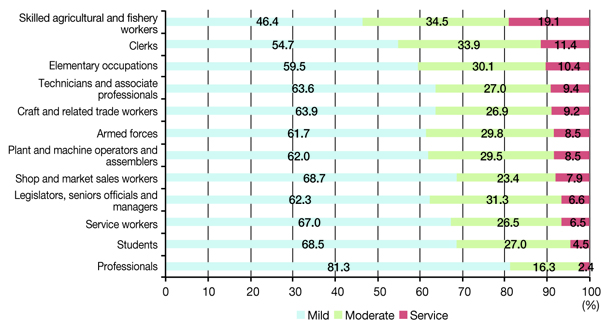J Korean Med Assoc.
2012 Nov;55(11):1070-1077.
The status of agricultural injuries in Korea and implications
- Affiliations
-
- 1Department of Preventive Medicine, Yonsei University Wonju College of Medicine, Wonju, Korea. oemdoc@yonsei.ac.kr
- 2Rural Development Administration, Suwon, Korea.
Abstract
- This study aims to investigate the status of agricultural injuries and to suggest measures to prevent and to manage them. To determine the scale of agricultural injuries in Korea, fatal injury data were analyzed by securing from the Annual Report on the Cause of Death Statistics and moderate to severe injuries were analyzed from the Emergency Department-based Injury Surveillance System (EDBISS). Nationwide data on minor injuries were analyzed from the Korea National Health and Nutrition Examination Survey (KNHANES), the Korean Working Condition Survey (KWCS), and the Farmers Survey of Occupational Injuries and Illness. The SMR of farmers was significantly higher than that of other occupations. When the distribution of severity of injury was investigated from the EDBISS data, the injury severity of farmers was higher than that of other occupations. The rate of industrial injuries from the KWCS data was 4.51% in skilled agricultural and fishery workers, which was around twice as high as those of craft and related trade workers (2.27%) and plant and machine operators and assemblers (2.13%). The occupational injury reporting rate from KNHANES was the second highest, or 4.3%, in skilled agricultural and fishery workers, following that of plant and machine operators (6.2%), while the rates of manual workers, sales and service workers, clerks and professionals, and managers and administrators were 3.5%, 3.0%, 2.7%, and 2.1%, respectively (P<0.001). Social concern over this issue, a reporting system for occupational injuries, preventive measures such as safety education programs, and an accident compensation system are needed to prevent and manage agricultural injuries.
Keyword
MeSH Terms
Figure
Reference
-
1. Robertson LS. Injury epidemiology. 1992. New York: Oxford University Press.2. Karjalainen A. International statistical classification of diseases and related health problems (ICD-10) in occupational health. 2000. Geneva: World Health Organization.
Article3. McCurdy SA, Carroll DJ. Agricultural injury. Am J Ind Med. 2000. 38:463–480.
Article4. Bureau of Labor Statistics. National census of fatal occupational injuries in 2007. 2008. Washington, DC: US Department of Labor.5. Pickett W, Hartling L, Brison RJ, Guernsey JR. Fatal work-related farm injuries in Canada, 1991-1995. Canadian Agricultural Injury Surveillance Program. CMAJ. 1999. 160:1843–1848.6. Tiesman H, Zwerling C, Peek-Asa C, Sprince N, Cavanaugh JE. Non-fatal injuries among urban and rural residents: the National Health Interview Survey, 1997-2001. Inj Prev. 2007. 13:115–119.
Article7. Statistics Korea. International statistics year book. 2009. Daejeon: Statistics Korea.
Article8. Jung DY, Kim HC, Leem JH, Park SG, Lee DH, Lee SJ, Kim GW. Estimated occupational injury rate and work related factors based on data from the fourth Korea National Health and Nutrition Examination Survey. Korean J Occup Environ Med. 2011. 23:149–163.
Article9. Lyman S, McGwin G Jr, Enochs R, Roseman JM. History of agricultural injury among farmers in Alabama and Mississippi: prevalence, characteristics, and associated factors. Am J Ind Med. 1999. 35:499–510.
Article
- Full Text Links
- Actions
-
Cited
- CITED
-
- Close
- Share
- Similar articles
-
- Estimated rate of agricultural injury: the Korean Farmers' Occupational Disease and Injury Survey
- The Comparative Study on the Prevalence of Injury/Poisoning in the Agricultural and Fishery Population and the General Population
- Type and Characters of Agricultural Injury Subjective Burden
- Agricultural Accidents in Farm Workers
- Vascular injuries associated with lumbar disk surgery: medicolegal implications




